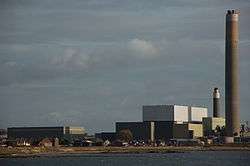Kilroot power station
| Kilroot power station | |
|---|---|
 Kilroot power station in November 2006 | |
 Location of Kilroot power station in Northern Ireland | |
| Country | Northern Ireland, UK |
| Location | Carrickfergus |
| Coordinates | 54°43′30″N 5°46′01″W / 54.725°N 5.767°WCoordinates: 54°43′30″N 5°46′01″W / 54.725°N 5.767°W |
| Status | Operational |
| Commission date | 1981 |
| Owner(s) |
The AES Corporation (AES Kilroot Power Ltd.) |
| Operator(s) |
Northern Ireland Electricity (1981-1992) AES Corporation (1992-present) |
| Thermal power station | |
| Primary fuel | Coal |
| Secondary fuel | Oil |
| Power generation | |
| Nameplate capacity | 660 MW |
|
Website www.aes.com | |
Kilroot power station is a coal and oil power station on the north shore of Belfast Lough at Kilroot near Carrickfergus in Northern Ireland, UK. The station generates 520 megawatts (MW) of electricity from dual coal and oil fuelled generators, along with approximately 140 megawatts (MW) from four Gas Turbines and 10 MW of battery energy storage from the Kilroot Advancion Energy Storage Array. Since the privatisation of Northern Ireland Electricity in 1992, the power station has been owned by the AES Corporation. It is the only coal-fired power station operating in Northern Ireland, and produces one third of the country's electricity. It is also one of County Antrim's top 100 employers.[1][2]
History
Kilroot power station was designed and built by Kennedy and Donkin, consultants for Northern Ireland Electricity (NIE), commencing in 1974.[2][3] The Cleveland Bridge Company also worked on the construction of the station.[4] The station was originally designed to use four 300 megawatt (MW) generating units. However, due to government spending restrictions in the early 1980s the project was truncated to two units. The station opened on 1 February 1981, when the first of the two generating unit went into operation. The plant was completed in 1982.[2][3] The power station was originally fueled by only oil, as it was the lowest cost fuel at the time. But following a change in generating policies in Northern Ireland in 1985 following the increase in oil prices, it was decided the plant would be converted burn coal as well as oil. This conversion took place between 1986 and 1989, and the power station has burned almost exclusively only coal ever since.[2]
The AES Corporation took over the station in a 50/50 partnership with Tractebel of Belgium in 1992 when NIE was privatised and sold its four power stations in Northern Ireland. Tractebel later sold their holding so that today Kilroot is solely run by AES.[5]
In December 2005, AES were granted permission to install Flue Gas Desulphurisation (FGD) equipment at the station. This was to help the station meet the EU Large Combustion Plant Directive by January 2008.[5]
Kilroot Power Limited opted into the Transitional National Plan of the Industrial Emissions Directive from 1st January 2016 to 30th June 2020. Environmental upgrades to the plant in 2015 ensured full compliance with emissions standards.
Specification
The main boilers were designed and built by Clarke Chapman. The station's turbo generators was designed and built by GEC. Each of the station's two units can dual-fire coal and oil, and have the capacity to produce 260 MW of electricity when burning oil.[2]
Operation

Coal is delivered to the jetty at Kilroot by small colliers typically capable of carrying 8,000 tonnes of coal. This is transferred by the collier's unloader onto Kilroot's conveyor, which transports the coal to the junction tower. From the junction tower the coal can be transported to the bunkers for immediate use or stored for later use. The Central Stacker Reclaimer (CSR) distributes the stored coal around itself ready to be reclaimed when the coal is required.
The coal in the bunker is transported to the mills via further conveyors, where the coal is pulverised into a gritty powder. The coal is then mixed with hot air as it is conveyed to the boiler for combustion, coal enters the boiler at several heights in the boiler and at the 4 corners. These coal feeders are positioned in order to maximise the efficient burning of the fuel. The coal is heated before entering the boiler to reduce the moisture content of the coal and increase efficiency.
The electricity is generated at 17 kilovolts (kV) and raised via transformers to 275 kV for transmission on the Northern Ireland electricity distribution grid.
Oil has been imported at the jetty at Kilroot since a modification during the Summer of 2009 and stored in 2 large storage tanks located adjacent to the main Carrickfergus Larne Road.
References
- ↑ "Our Business". AES. 2006. Retrieved 6 February 2011.
- 1 2 3 4 5 "Generating success" (PHP). www.modernutilitymanagement.com. 10 June 2010. Retrieved 22 February 2011.
- 1 2 "Kilroot Power Station". www.r-e-a.net. Archived from the original on July 24, 2011. Retrieved 31 January 2011.
- ↑ "A - Z list of Bridges Built by Cleveland Bridge Company". Newcastle University. Retrieved 18 April 2011.
- 1 2 "Kilroot Power Station". 22 December 2005. Retrieved 31 January 2011.
External links
| Wikimedia Commons has media related to Kilroot power station. |